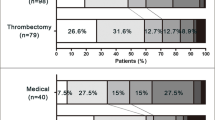Abstract
Background
We investigated the prevalence and mechanisms of neurological deterioration after endovascular thrombectomy.
Methods
Between January 2011 and October 2017, acute ischemic stroke patients treated by endovascular thrombectomy in a tertiary university hospital were included. Early neurological deterioration (END) was defined as an increase of 2 or more National Institute of Health Stroke Scale (NIHSS) compared to the best neurological status after stroke within 7 days. The END mechanism was categorized into ischemia progression, symptomatic hemorrhage, and brain edema.
Results
A total of 125 acute ischemic stroke patients received endovascular thrombectomy. Neurological deterioration was detected in 44 patients, and 38 cases (86.4% of END) occurred within 72 h. The END mechanism included 20 ischemia progression, 16 brain edema and 8 hemorrhagic transformation cases. Multivariable logistic regression analysis revealed that the patients who experienced END were more likely to have poor functional outcome defined as modified Rankin scale 3–6 at 90 days than neurologically stable patients (odds ratio (OR) = 4.06, confidence interval (CI) = 1.39–11.9). The risk factor of END due to ischemia progression was stroke subtype of large artery atherosclerosis (OR = 6.28, CI = 1.79–22.0). Successful recanalization (OR = 0.11, CI = 0.03–0.39) and NIHSS after endovascular thrombectomy (OR = 1.15 per one-point increase, CI = 1.06–1.24) were significantly associated with END due to hemorrhage or brain edema.
Conclusion
Neurological deterioration frequently occurs after endovascular thrombectomy, and the risk factors of END differ according to the mechanism of END.
Similar content being viewed by others
References
Berkhemer OA, Fransen PS, Beumer D, van den Berg LA, Lingsma HF, Yoo AJ et al (2015) A randomized trial of intraarterial treatment for acute ischemic stroke. N Engl J Med 372:11–20
Goyal M, Demchuk AM, Menon BK, Eesa M, Rempel JL, Thornton J et al (2015) Randomized assessment of rapid endovascular treatment of ischemic stroke. N Engl J Med 372:1019–1030
Saver JL, Goyal M, Bonafe A, Diener HC, Levy EI, Pereira VM et al (2015) Stent-retriever thrombectomy after intravenous t-PA vs. t-PA alone in stroke. N Engl J Med 372:2285–2295
Campbell BC, Mitchell PJ, Kleinig TJ, Dewey HM, Churilov L, Yassi N et al (2015) Endovascular therapy for ischemic stroke with perfusion-imaging selection. N Engl J Med 372:1009–1018
Jovin TG, Chamorro A, Cobo E, de Miquel MA, Molina CA, Rovira A et al (2015) Thrombectomy within 8 hours after symptom onset in ischemic stroke. N Engl J Med 372:2296–2306
Goyal M, Menon BK, van Zwam WH, Dippel DW, Mitchell PJ, Demchuk AM et al (2016) Endovascular thrombectomy after large-vessel ischaemic stroke: a meta-analysis of individual patient data from five randomised trials. Lancet 387:1723–1731
Powers WJ, Derdeyn CP, Biller J, Coffey CS, Hoh BL, Jauch EC et al (2015) 2015 American Heart Association/American Stroke Association focused update of the 2013 guidelines for the early management of patients with acute ischemic stroke regarding endovascular treatment: a guideline for healthcare professionals from the American Heart Association/American Stroke Association. Stroke 46:3020–3035
Hong KS, Ko SB, Yu KH, Jung C, Park SQ, Kim BM et al (2016) Update of the Korean Clinical Practice Guidelines for Endovascular Recanalization Therapy in Patients with Acute Ischemic Stroke. J Stroke 18:102–113
Espinosa de Rueda M, Parrilla G, Manzano-Fernández S, García-Villalba B, Zamarro J, Hernández-Fernández F et al (2015) Combined multimodal computed tomography score correlates with futile recanalization after thrombectomy in patients with acute stroke. Stroke 46:2517–2522
Hussein HM, Georgiadis AL, Vazquez G, Miley JT, Memon MZ, Mohammad YM et al (2010) Occurrence and predictors of futile recanalization following endovascular treatment among patients with acute ischemic stroke: a multicenter study. Am J Neuroradiol 31:454–458
Adams HP Jr, Bendixen BH, Kappelle LJ, Biller J, Love BB, Gordon DL et al (1993) Classification of subtype of acute ischemic stroke. Definitions for use in a multicenter clinical trial. TOAST. Trial of Org 10172 in Acute Stroke Treatment. Stroke 24:35–41
Suh SH, Cloft HJ, Fugate JE, Rabinstein AA, Liebeskind DS, Kallmes DF (2013) Clarifying differences among thrombolysis in cerebral infarction scale variants: is the artery half open or half closed? Stroke 44:1166–1168
Kim JM, Moon J, Ahn SW, Shin HW, Jung KH, Park KY (2016) The etiologies of early neurological deterioration after thrombolysis and risk factors of ischemia progression. J Stroke Cerebrovasc Dis 25:383–388
Kim JM, Jung KH, Sohn CH, Moon J, Han MH, Roh JK (2016) Intracranial plaque enhancement from high resolution vessel wall magnetic resonance imaging predicts stroke recurrence. Int J Stroke 11:171–179
Jüttler E, Unterberg A, Woitzik J, Bösel J, Amiri H, Sakowitz OW et al (2014) Hemicraniectomy in older patients with extensive middle-cerebral-artery stroke. N Engl J Med 370:1091–1100
Jeon SB, Koh Y, Choi HA, Lee K (2014) Critical care for patients with massive ischemic stroke. J Stroke 16:146–160
Su Y, Fan L, Zhang Y, Zhang Y, Ye H, Gao D et al (2016) Improved neurological outcome with mild hypothermia in surviving patients with massive cerebral hemispheric infarction. Stroke 47:457–463
Sheth KN, Elm JJ, Molyneaux BJ, Hinson H, Beslow LA, Sze GK et al (2016) Safety and efficacy of intravenous glyburide on brain swelling after large hemispheric infarction (GAMES-RP): a randomised, double-blind, placebo-controlled phase 2 trial. Lancet Neurol 15:1160–1169
Josephson SA, Hills NK, Johnston SC (2006) NIH Stroke Scale reliability in ratings from a large sample of clinicians. Cerebrovasc Dis 22:389–395
Acknowledgements
The work was supported by the Basic Science Research Program through the National Research Foundation of Korea (NRF) funded by the Ministry of Education (NRF-2016R1D1A1B03933891). The funding has no role in the design, collection, analysis, or interpretation of data; in the writing of the manuscript; and in the decision to submit the manuscript for publication.
Author information
Authors and Affiliations
Corresponding author
Ethics declarations
Conflicts of interest
All the authors declare that they have no conflict of interest.
Rights and permissions
About this article
Cite this article
Kim, JM., Bae, JH., Park, KY. et al. Incidence and mechanism of early neurological deterioration after endovascular thrombectomy. J Neurol 266, 609–615 (2019). https://doi.org/10.1007/s00415-018-09173-0
Received:
Revised:
Accepted:
Published:
Issue Date:
DOI: https://doi.org/10.1007/s00415-018-09173-0




